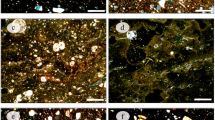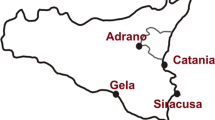Abstract
During the archeological excavations carried out from 1993 to 1995 at C.da Portinenti, at Lipari Island, a pottery workshop dated to Roman age—including a kiln dump containing both Richborough 527 type amphora wastes and ceramic shreds—was discovered. The Richborough 527 amphorae had been used to transport local volcanic and hydrothermal products throughout the Roman Empire. Here, we present the results of a multidisciplinary archaeometric study carried out with the aim to shed light on the provenance of the raw materials used in the production of the Richborough 527 amphorae. To achieve this goal, amphora wastes and a sample of yellow clays stored in the archeological excavation area have been analyzed, and the data were compared to those available for clays coming from Lipari and from the Messina Province. The overall results indicate that (i) a volcanic sand from Portinenti Valley was used as temper in the ceramic mixture; (ii) the geochemical features and the fossils present in the ceramic paste are compatible with marine Pleistocene clayey deposits of the Messina Province and incompatible with the clays of Lipari island; (iii) the yellow clays found in the excavation area were not used to produce the Richborough 527; and (iv) the analyzed wastes are the results of a poorly controlled firing temperature during the ceramic artifact production.








Similar content being viewed by others
References
Baldanza, A., Belfiore, M.C., Di Bella, M., Pino, P., Sabatino, G., Triscari, M., 2010. Georisorse per le costruzioni in laterizio di Taormina e Naxos (Sicilia Nord-Orientale): dati petro-chimici e micropaleontologici. In: Atti Congresso Nazionale di Archeometria, AIAr “Riflessioni e trasparenze: diagnosi e conservazione di opere e manufatti vetrosi”, Ravenna 24–26 Febbraio 2009, Patron Editore, Bologna, 339–350
Bernabò-Brea, L., Cavàlier, M., 2000a. Discariche di fornace romana e necropoli greche in contrada Portinenti. Meligunis Lipara, X, Rome, 255–482
Bernabò-Brea, L., Cavàlier, M. 2000b. “Discariche di fornace romana e necropoli greche in contrada Portinenti”. Meligunis Lipara, X, Rome, 255–482
Borgard, P., 1994. L’origine liparote des amphores. Société Française d’Étude de la Céramique Antique en Gaule. Actes du congrès de Millau (1994). SFECAG, 197–203
Borgard, P. (2000). L’atelier de potiers du vallon de Portinenti (Lipari). Note preliminare sur la production amphorique (Ier s. av. J.-C.-III s. ap. J.-C.). In Meligunis Lipara, X, Rome, 273–297
Borgard, P., 2001. L’alun de l’Occident romain. Production a 11ethods11tion des amphores romaines de Lipari”. Thèse de doctorat, Université de Provence (Aix-Marseille I). Document dactylographié, 4 volumes
Borgard, P., Cavalier, M., 2003. Avec la participation de M. Picon et de R. Tomber. The Lipari origin of the Richborough 527. Journal of Roman Pottery Studies, 10, (2003) - Actes du colloque de Londres, 23–24 janvier 1994: Roman amphorae. Problems of identification and methodology, 96–106
Borgard, P., Gateau, F., 1991. Des amphores canneleés à Cavaillon (Vaucluse) à la fin du 1er 11 ethod avant notre ère. Nouveaux 11 ethods 11 pour l’étude des Richborough 527, in Actes du Congrès de Cognac. 8–11 Mai 1991, L. Rivet ed., SFECAG, Marseille, 311–28
Borgard, P., Gateau, F. Chedru, B., Knowles, K., 1991. Des amphores cannelées à Cavaillon (Vaucluse) à la fin du 1er siècle avant notre ère. Nouveaux 11ethods11 pour l’étude des Richborough 527. Société Française d’Étude de la Céramique Antique en Gaule. Actes du 11ethods11 de Cognac (1991). SFECAG, 311–325
Capelli, C., Borgard, P., 2003. “Origine et typologie des amphores a alun de Lipari: données archéologiques et archéometriques.” L’alun de méditerrannée. Actes du colloque international. Napoli-Lipari 2003
Cavalier, M., 1994. Les amphores Richborough 527. découverte d’un atelier à Portinenti (Lipari, Italie)”. Aetes du Congrès de Millau. 12–15 mai 1994 (SFECAG), Marseille, 189–196
Cultrone G, Rodriguez-Navarro C, Sebastian E, Cazalla O, De La Torre MJ (2001) Carbonate and silicate phase reactions during ceramic firing. J Eur Ceram Soc 13:621–634
Cultrone G, Sebastian E, Elert K, De La Torre MJ, Cazalla O, Rodriguez-Navarro C (2004) Influence of mineralogy and firing temperature on the porosity of bricks. J Eur Ceram Soc 24:547–564
Di Bella M, Italiano F, Sabatino G, Tripodo A, Baldanza A, Casella S, Pino P, Rasa R, Russo S (2016) Pleistocene volcaniclastic units from north-eastern Sicily (Italy): new evidence for calc-alkaline explosive volcanism in the Southern Tyrrhenian Sea. Geol Carpath 67(4):371–389
Forni, F., 2011. Petrology and geochemistry of Lipari Island (Aeolian archipelago): constraints on magma genesis and evolution. PhD thesis, University of Bologna, 1–257
Forni, F., Lucchi, F., Peccerillo, A., Tranne, C.A., Rossi, P.L., & Frezzotti, M.L., 2013. In Lucchi, F., Peccerillo, A., Keller, J., Tranne, C.a., Rossi, P.L., (Eds.), The Aeolian islands volcanoes, 37, 213–279, London: Memoirs Geological Society
Gillikin DP, Jacques Navez AL, Taylor JW, Eddy Keppens LA, Baeyens W, Dehairs F (2005) Strong biological controls on Sr/Ca ratios in aragonitic marine bivalve shells. Geochemistry, Geophysics and Geosystems 6(5):1–16
Laffranque M (1957) Poseidonios d’Apamée et les mines d’Ibérie. Pallas, Revue d’etudes antiques 5:17–25
Mottana A (2001) Il pensiero di Teofrasto sui metalli secondo i frammenti delle sue opere e le testimonianze greche, latine, siriache ed arabe. Rend Fis Acc Lincei 9(12):133–241
Parker, A.J., 1992. Ancient shipwrecks of the Mediterranean and the Roman Provinces, BAR Internat. Ser. 580, Oxford
Peacock DPS (1977) Roman amphorae: typology, fabric and origin. Méthodes classiques et methods formelles dans l’étude des amphores Collection de L’École Française de Rome 32:261–278
Peacock DPS, Williams DF (1986) Amphorae and the Roman economy. Longman, London, pp 111–112
Photos-Jones, E., Hall, A.J, 2008. Lemnian earth and the earths of the Aegean, an archaeological guide to medicines, pigments and washing powders. Potingair Press Glasgow, 1–115
Pearce BW (1968) Roman coarse ware. In: Cunliffe BW (ed) Fifth report on the excavations of the Roman fort at Richborough. Kent, London, pp 117–124
Peccerillo A (2005) Plio-quaternary volcanism in Italy: Petrology, geochemistry, geodynamics. SpringerVerlag Berlin, Heidelberg, pp 365
Pino, P., Baldanza, A., Belfiore, C., Di Bella, M., Sabatino, G., Triscari, M., 2007. Selected clay units in the Messina Province (NE Sicily): a stratigraphic review. Epitome vol. 2, Geoitalia 2007, VI Forum Italiano di Scienze della Terra, Rimini, 12–14 settembre 2007, 401
Pittinger J (1975) The mineral products of Melos in antiquity and their identification. dans ABSA 70:191–197
Pouchou JL, Pichoir L (1984) Possibilités d’analyse en profondeur à la microsonde électronique. J Microsc Spectrosc Electron n 9:99–100
Pouchou JL, Pichoir L (1985) Les elements très légersen microanalyse X: Possibilités des modèles récents de quantification. J Microsc Spectrosc Electron 11:229–250
Triscari, M., Baldanza, A., Belfiore, C., Di Bella, M., Pino, P., Sabatino, G., Tigano, G., 2007. Clay units in NE Sicily: an integrated map and database finalized to archaeometric provenance studies. Epitome vol. 2, Geoitalia 2007, VI Forum Italiano di Scienze dellaTerra, Rimini 12–14 settembre 2007, 469
Acknowledgments
We thank two anonymous referees for the careful reading of the manuscript and their constructive comments, which improved the quality of the paper. G. Bueti and S. Larinà are thanked for their contribution to this research project, given during their degree work.
Author information
Authors and Affiliations
Corresponding author
Electronic supplementary material
Fig. S1
XRPD patterns of the analyzed clay samples: A) Clay-Port and Clay-Fuardo; B) Clay-Messina (PNG 183 kb)
Fig. S2
Distribution of Quaternary marine marly-clays deposits (Pleistocenic Clay Complex) outcropping along the north-eastern coast of Sicily, identified as possible supply area of raw materials used for the production of Richborough 527 amphorae (PNG 1155 kb)
ESM 1
(XLSX 17 kb)
Rights and permissions
About this article
Cite this article
Di Bella, M., Mastelloni, M.A., Baldanza, A. et al. Archaeometric constraints by multidisciplinary study of Richborough 527 amphorae and yellow clays from the C.da Portinenti pottery workshop (Lipari Island, Italy). Archaeol Anthropol Sci 11, 2957–2970 (2019). https://doi.org/10.1007/s12520-018-0727-2
Received:
Accepted:
Published:
Issue Date:
DOI: https://doi.org/10.1007/s12520-018-0727-2




